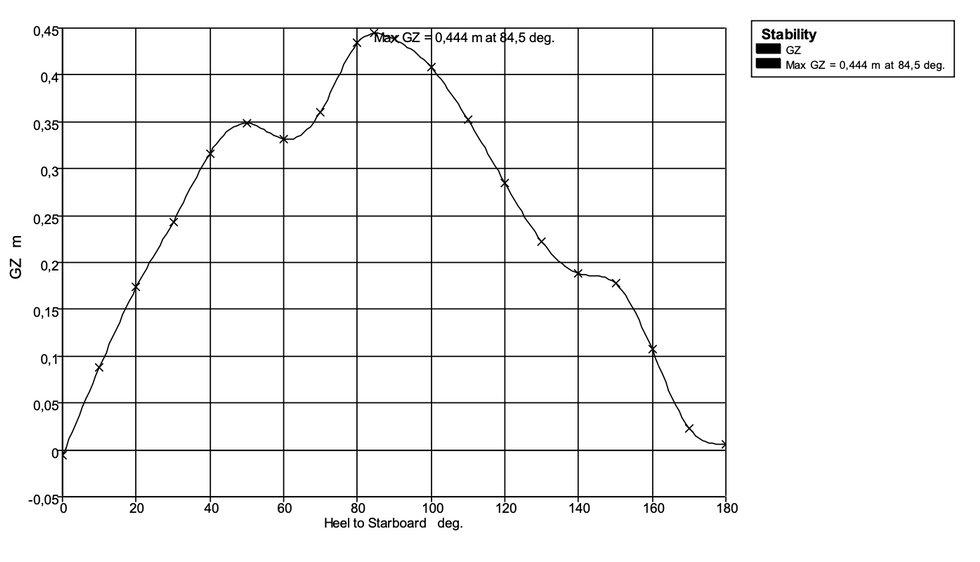Explorer Yacht Stability - The Results Are In!
- Chris Leigh-Jones
- Nov 25, 2023
- 3 min read
This week, we will return to the subject of longitudinal stability. It's a pet peeve of mine. Following a recent blog, we have established a measured KG (Center of Gravity) for a given load condition, allowing us to override some prior assumptions with factual data. Before going further, though, I'd just like to repeat a previous opening statement:
Dunning Kruger - "When a person's lack of knowledge or skill in a certain area causes them to overestimate their competence." I'm not a Naval Architect!
Injecting Factual Stability Data
First, we ballasted the forepeak tanks with just over 4T of fresh water to control our 9s roll period. It's still high at 7s, but at least manageable in our very lightship condition (targeting 5.2-5.5s in "Arrival" trim).
We then undertook an "Inclining Experiment" to establish the lightship Center of Gravity (KG) for this load condition.
We then used this known figure in our calculation model (MaxSurf) and set the various load conditions for Arrival Loaded, Departure Loaded, and Arrival - Launching Tender.
We have a best guess for the water ballast under these various conditions (Via Steve Parsons at Eyes Expeditions, ex-FPB commissioning Captain) and assumed Departure is 100% fuel and Arrival an extreme <20% fuel.
MGN 280 for stability - Category (0) Unrestricted
We can play with fixed and water ballast under various conditions such that the estimated stability results satisfy the requirements of MGN 280, Section 11.3, Motor Vessel under 24m LOA. (Motor Vessel operating in Category 0 as per Section 11.1.1.2) What were we looking for exactly? I'll quote from MGN 280 directly:
The curves of statical stability for the loaded conditions should meet the following criteria:-
The area under the righting lever curve (GZ curve) should be not less than 0.055 meter -radians up to 30 degrees angle of heel and not less than 0.09 meter - radians up to 40 degrees angle of the heel or the angle of down flooding if this angle is less;
The area under the GZ curve between the angles of the heel of 30 and 40 degrees or between 30 degrees and the angle of downloading, if this is less than 40 degrees, should be not less than 0.03 meter - radians;
The righting lever (GZ) should be at least 0.20 meters at an angle of the heel equal to or greater than 30 degrees;
The maximum GZ should occur at an angle of the heel of not less than 25 degrees, and
After correction for free surface effects, the initial metacentric height (GM) should not exceed 0.35 meters.
We also get:
Trim: by the stern under all conditions, even keel accepted.
List: can be adjusted; not important at this point
The angle of Vanishing Stability:>120 degrees
Tank conditions: for Arrival and Departure
Fixed Ballast: total AND location throughout the vessel for a full compliment, inc. tender and crew of 8 people.
Below are GZ curves for three load conditions.
Departure with full fuel,
Arrival at 20% fuel
Arrival and launching the tender (WORST CASE).
The curves show an unusual double hump feature. This results from the saloon beginning to assist in buoyancy as the deck edge submerges. Unlike many motor yachts, the saloon windows are bulletproof, creating a watertight enclosure under such conditions.
Results of Stability Tests and Calculations
This work resulted in the following conclusions:
We need 2.25 T of lead ballast at 4 locations along the hull. Ballast will also balance an existing permanent port list sans the tender.
With the addition of lead ballast, we have sufficient water ballast to compensate for fuel usage under Arrival conditions.
We can launch our Tender without listing dangerously.
We can remain within MGN280 Stability Criteria in all realistic load conditions.
Vanguard has a long, narrow and hopefully very efficient hull shape. She will roll gently being generally on the tender side without stabilizers operating. She is in absolutely no danger of becoming unstable under most conceivable conditions. When she does roll it will be with a good margin of safety and little risk of consequential down flooding. Job well done!. Further confirmation of the above will happen when MCA officially approves another test and scrutinizes the resultant Stability Book.
My thanks for their indulgence to:
Dincer Dinc is the Technical Director of Naval Yachts.
Eyos Expeditions from some awesome contacts!
Chris Leigh-Jones
I have heard a figure of 180 degrees bandied about the Angle of Vanishing Stability (AVS). In other words, a rollover. The reality of that is something different, and if it ever happens, then it's probably your least immediate worry. Refrain from being attracted by this statement; it's for marketing pamphlets only. Practical stability and avoiding down flooding when heeled are of greater interest to us.












